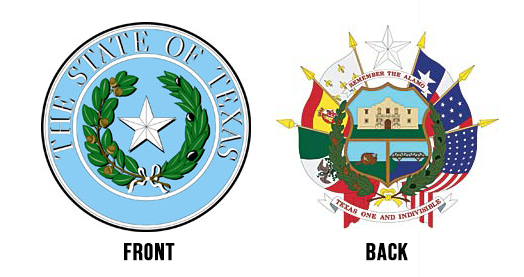Today, the seal of the state of Texas has developed into a uniform design with both a front (obverse) and a reverse side. By law, the seal is required to authenticate official documents of the state. The origins of the seal go back to the early days of the republic.
The Obverse (Front)
The Convention of 1836 convened on March 2 at Washington on the Brazos and declared independence from Mexico. Ten days later, the convention adopted a resolution providing for “a single star of five points” as the “peculiar emblem” of the Republic. At least when used on official documents, the seal was to be either gold or silver in color.
Later that same year, the newly formed government of the republic passed a bill which refined somewhat the original description of the seal. Thus, it declared, “for the future, the national seal of this republic shall consist of a single star, with the letters ‘Republic of Texas,’ circular on said seal, which seal shall also be circular.” Ad interim President David Burnet first proposed this description, and Sam Houston, who replaced Burnet as president, approved the design on December 10, 1836.
The Third Congress of the Republic of Texas modified the seal in 1839, adding a live oak branch (to represent strength) and an olive branch (to represent peace). The resulting design, basically, is the one used today. When Texas joined the United States in 1845, the design of the seal was retained, with the change only of the word “Republic” to “State”.
Over the next century and a half, the various departments of the state government evolved more than a dozen different renderings of the basic seal design. To ensure more uniform usage, an official implementation of the seal (as shown above left) was adopted by the Secretary of State in 1992.
The Reverse (Back)
The reverse of the Texas state seal (above right) developed much later than the obverse. It was adopted in 1961, based on a design proposed by the Daughters of the Republic of Texas. It consists of a shield surrounded by the six national flags that have flown over Texas. Atop the shield is the familiar lone star from which Texas derived its nickname. A narrow banner across the upper part of the seal displays the words “Remember the Alamo”. A similar banner at the bottom reads “Texas One and Indivisible”.
The reverse of the seal is used only as a decorative symbol. Unlike the obverse seal, the reverse does not carry with it any legal use or significance.
Sources:
Walter Prescott Webb (Editor), The Handbook of Texas, Texas State Historical Association, Austin, 1952
Spain, Jr., Charles A., The Flags and Seals of Texas, South Texas Law Review (Houston), 33 (February 1992), p. 215-259.
